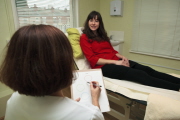
Acupuncture

Traditional Acupuncture is one of the world's oldest systems of medicine, with an estimated three million practitioners worldwide. In recent years , acupuncture has become recognised in many countries of the world for is ability to address chronic and debilitating conditions, in addition to the treatment of pain for which it was previously better known. Acupuncture seeks to re-establish the balance of your vital energy (which in Chinese Medicine is known as 'qi'), therein recovering your mental, emotional and physical equilibrium. For the most part, people come when they are suffering from an illness or injury. However, increasingly, people are looking to acupuncture as a means of improving or maintaining their wellbeing, and keeping illness at bay.
Your First Visit

On your first visit you will receive a Traditional Diagnosis that lasts in the region of 1 ½ to 2 hours. A full case history will be taken and a number of diagnostic techniques will be applied including tongue diagnosis and pulse taking. In most cases you will also receive your first treatment. The Traditional Diagnosis session is extremely important as it enables the practitioner to ascertain the state of your energy (qi) and to determine how to best rectify energetic imbalances to facilitate the healing process.
How often will I need to visit ?
We are all unique so the amount of treatment varies from person to person. In most cases patients are advised to come weekly initially and then as progress is maintained treatments are spaced out gradually until only a top up treatment is required. Generally we would expect improvement by 6-10 treatments. However, some people see improvement before this, and for some it takes longer. Your main complaint isn't necessarily the first to respond. The benefits of acupuncture frequently include more than just relief from a particular condition. Many people find that it can also lead to increased energy levels, better appetite and sleep as well as an enhanced sense of overall well being.
What happens during an Acupuncture treatment?

Five Element Acupuncture uses a 'fine needle technique'. Essentially this means that the needles are hair like, and the depth of the needling is very shallow. The sensation caused by the needle action is related to the nature of the acupuncture point selected, not the depth of the needle. People report the sensation as a 'dull ache', 'warmth' 'small insect bite'. Sometimes people don't feel a thing. However, if you are someone who is sensitive to acupuncture stimulation, your acupuncturist will work with you to make sure that your treatment is as comfortable as possible.
During your course of acupuncture you may become familiar with the other adjuncts to acupuncture frequently used in the clinic such as:
Moxibustion


Moxa is the ground down leaves of the artemesia vulgaris latiflora plant. As illustrated below, it is rolled into small cones, and then ignited with a little incense stick so that it sends warmth to a point before the needle action. The moxa is removed from the skin before it gets overwarm, and then the acupuncture point is needled.
Cupping

Cupping can often be used where there is a large area of pain. A vacuum is created in the cup so that creates a slight 'suction'. Cups are then either left in place, or moved up and down creating a massaging action. This stimulates blood circulation, which can resolve pain.
Gua Sha
Gua Sha is a 'grass roots' folk medicine traditionally used in Asian countries.Gua sha involves repeated pressured strokes over lubricated skin with a smooth edge. Traditionally a ceramic Chinese soup spoon was used, or a well worn coin, even honed animal bones, water buffalo horn, or jade. In clinic, a simple metal cap with a rounded edge is commonly used.